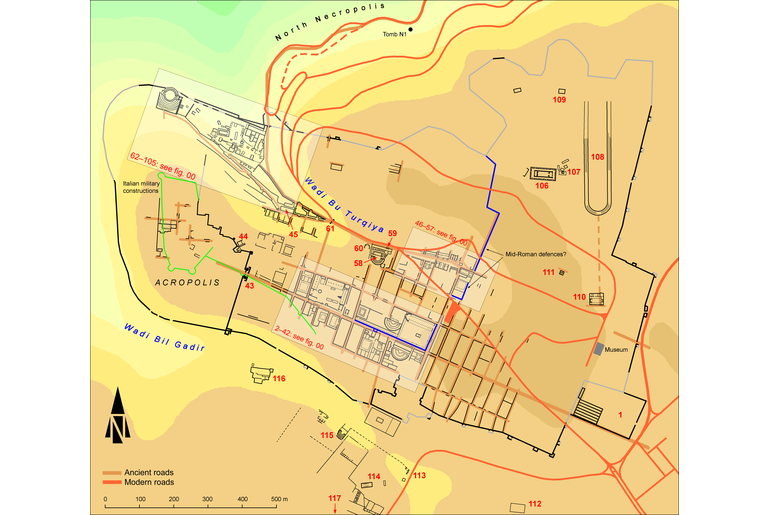Unclear graffito
IGCyr079200
Trismegistos ID: 738376
Source Description
Repository
Cyrene Museum, Storeroom of the American excavations, sherdboxes 23.3, 34.3 and 42.1.
Support
Three non-joining fragments of Attic black figure ware amphora, all from a flaring mouth of estimated diameter 0.20; presuming that the dimension given by the editor is the width, it is for fragment a 0.117, for fragment b 0.127, for fragment c 0.082.
Layout
Incised on the flat top of the rim, all three fragments form a single line.
Letters
Height unknown; alpha with inclined central bar, digamma, three-strokes iota, symmetrical lambda, + as khi.
Place of Origin
Findspot.
Date
Second quarter of sixth century B.C. (context)
Findspot
Found between 1969 and 1978 at Cyrene pleiades; HGL : Enclosed sanctuary of Demeter and Kore , area E11.
Present Location
Not seen by IGCyr team.
Text constituted from
Transcription from previous editor.
Bibliography
Moore, 1987 Moore, M.B., 1987, Attic Black Figure and Black Glazed Pottery, in D. White (ed.), The Extramural Sanctuary of Demeter and Persephone at Cyrene, Libya: Final Reports, III, University Museum monograph66, Philadelphia, 21-52 - see in bibliography , n. 5 (ph.), whence SEG Supplementum Epigraphicum Graecum, Leiden, then Amsterdam, 1923-1971, then 1979- - see in bibliography , 37.1703. Cf. Dobias-Lalou, 2015 Dobias-Lalou, C., 2015, Les débuts de l'écriture en Cyrénaïque, in A. Inglese, Epigrammata 3. Saper scrivere nel Mediterraneo antico. Esiti di scrittura fra VI e IV sec. a.C., in ricordo di Mario Luni. Atti del convegno di Roma, 7-8 Novembre 2014, Tivoli, 59-80, 315-321 - see in bibliography , pp. 62-63.
Apparatus
Fragm. b
b (Moore gives a diplomatic edition without any interpretation) SEG Supplementum Epigraphicum Graecum, Leiden, then Amsterdam, 1923-1971, then 1979- - see in bibliography [---] +LOKRO[---] (in Latin alphabet)
French translation
Intraduisible.
English translation
Not usefully translatable.
Italian translation
Intraducibile.
Commentary
The editor gave only a diplomatic transcription, from which SEG gave an inaccurate transcription into Ionic alphabet, and even into Latin alphabet for fragm. b!
The first letter of fragm. b being incomplete might be an epsilon or rather a digamma as Moore, 1987 Moore, M.B., 1987, Attic Black Figure and Black Glazed Pottery, in D. White (ed.), The Extramural Sanctuary of Demeter and Persephone at Cyrene, Libya: Final Reports, III, University Museum monograph66, Philadelphia, 21-52 - see in bibliography proposes. The second letter cannot be anything but a lambda, with a shape that does not belong to the Attic archaic alphabet. The name of the Locrians seems to stay here either as an ethnic or as a personal name. If the digamma was sure, it would give a clue to its etymology. However, as no other document, in Locria or elsewhere, does confirm such a fact, it seems more cautious to admit here an epsilon, which would be the end of the preceding word.
The final letter of fragm. c and the last letter of fragm. a are three-stroke iotas.
Fragm. c is a good candidate for the end of a sentence, followed by a blank. Both other fragments might also be taken in order b-a.
Creative Commons Attributions-NonCommercial 4.0 International License.
All citation, reuse or distribution of this work must contain a link back to DOI: http://doi.org/10.6092/UNIBO/IGCYRGVCYR and the filename (IGCyr000000 or GVCyr000), as well as the year of consultation.
